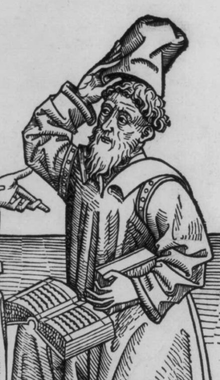Borzuya(orBurzōēorBurzōyorBorzouyeh,Persian:بُرْزویه) was aPersianphysician in the lateSasanian era,at the time ofKhosrow I.[2]He translated the IndianPanchatantrafromSanskritintoPahlavi (Middle Persian).Both his translation and the original Sanskrit version he worked from are lost. Before their loss, however, his Pahlavi version was translated intoArabicbyIbn al-Muqaffaunder the title ofKalila wa-DimnaorThe Fables of Bidpaiand became the greatest prose of Classical Arabic. The book contains fables in which animals interact in complex ways to convey teachings to princes in policy.
Borzuya | |
|---|---|
 Artwork of Borzūya | |
| Born | 5th century – 6th century |
| Died | 6th century |
| Education | Academy of Gondishapur(possibly) |
| Known for | Translating many books intoPahlavi |
| Medical career | |
| Profession | Physician |
The introduction toKalila wa-Dimnapresents an autobiography by Borzūya. Beside his ideas, cognitions and inner development leading to a practice of medicine based on philanthropic motivations, Borzuya's search for truth, his skepticism towards established religious thought and his later asceticism are some features lucidly depicted in the text.[3]
Voyage to India
editBorzuya was sent to India by Khosrow I to find a plant that is capable of reviving the dead. He later learned from a philosopher that the plant he is seeking is actually a book, thePanchatantra,that is locked in the treasury of the rajah.[4][5]He received permission to read the book from the rajah[clarification needed],although he was not permitted copy it. Disobeying these instructions, Borzuya would memorize the text he read each day and secretly wrote the book again in Persian, then sent his translation back to his king.[1]When he returned, Khosrow praises the work, stating "the book calledKalilahas given my soul new life ", and offers Borzuya any reward he chooses from the royal treasury. Instead of gold or jewels, Borzuya chooses a fine suit of clothes and that his name be written in the copy of theKalila"so that after I die, learned men will not forget the difficulties I went through".[4]
The Semitic scholar François de Blois describes five distinct versions of Borzuya's voyage to India. The versions vary in details of the reasons Borzuya was originally sent to India, the purpose of his trip, and how Borzuya obtained access to thePanchatantra.Scholar disagree as to which of the versions is older and can be traced back to the author of the Pahlavi translations, but agree that the themes of Khosrow's interest in Indian knowledge, particularly of statecraft, the difficulty in obtaining access to the book, etc.[3]
There is considerable discussion whether Borzūya is the same asBozorgmehr.[3]While sources indicate they are different people, the word "Borzūya"cansometimes be a shortened form of Bozorgmehr.[6]
See also
editReferences
edit- ^ab"BORZŪYA".Encyclopædia Iranica.December 15, 1989.
- ^Zargaran, Arman; Mehdizadeh, Alireza; Yarmohammadi, Hassan; Kiani, Hossein; Mohagheghzadehl, Abdolali (2015). "Borzouyeh, an Ancient Persian Physician Who First Reported Uterine Contractions in Normal Vaginal Delivery".Acta medico-historica Adriatica.13(Suppl 2): 23–28.ISSN1334-4366.PMID26959628.
- ^abcFrançois de Blois (1990),Burzōy's voyage to India and the origin of the book of Kalīlah wa Dimnah,Routledge,ISBN978-0-947593-06-3
- ^abKinoshita, Sharon (2008-12-01). "Translatio/n, empire, and the worlding of medieval literature: the travels ofKalila wa Dimna".Postcolonial Studies.11(4): 371–385.doi:10.1080/13688790802456051.ISSN1368-8790.S2CID143500773.
- ^Roy, Nilanjana S."The Panchatantra: The ancient 'viral memes' still with us".BBC.Retrieved17 March2019.
- ^Djalal Khaleghi-Motlagh, "BORZŪYA" inEncyclopædia Iranica.Oneline link accessed in December 2010:BORZŪYA.